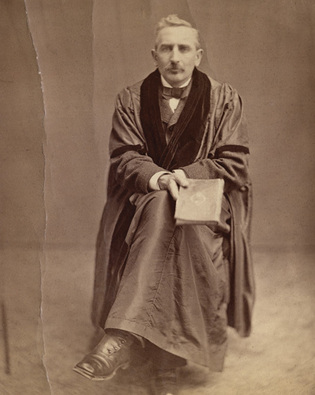 loading
loading
Old YaleThe art of compromiseThe art school's first dean tried to balance art and administration.  Manuscripts & ArchivesFounding art school dean John Ferguson Weir served as his own model for his statue of President Woolsey that stands on the Old Campus. View full imageIn 1869, 28-year-old John Ferguson Weir, who had begun to win national recognition as a painter, was invited to become the founding dean of Yale’s new art school. He worried that the duties would interfere with his painting, but told himself that “it would be a simple matter to withdraw should it prove detrimental.” Weir ended up staying for 44 years. The relationship between artistic freedom and administrative responsibility was one he would navigate his entire working life. He managed to continue producing art that earned plaudits and profits, if never to the same level as before, even as he built what would become a world-class art school. In entering academia, Weir (1841–1926) followed his father. He was one of the 16 children of Robert Walter Weir, a painter who taught drawing at West Point. Though the younger Weir did not attend college or art school, he was educated by his father and other West Point professors. Also like his father, Weir became a painter. (A brother, J. Alden, became a leading American Impressionist.) In 1864, his first exhibited painting—a view of his father’s studio—led to Weir’s election as an associate of the National Academy of Design. He exhibited his next work, The Gun Foundry, in 1866 to great critical praise. After selling the picture for $5,000, Weir married Mary French, the West Point chaplain’s daughter. In 1868 he completed his third great painting, Forging the Shaft. (Fire destroyed the original in 1869, but Weir’s reproduction now hangs in the Metropolitan Museum.) When Yale president Theodore Dwight Woolsey ’20, ’23MA, wrote to offer Weir the deanship of the School of Fine Arts—the first such school within a university (see Old Yale, September/October 2009)—Weir hesitated. But after a visit to New Haven, he decided the school “seemed most attractive and important in its possibilities.” There was hard work ahead. Only four students were enrolled when the school opened. Facing a college faculty indifferent to Yale’s professional schools and an administration frequently reluctant to let Yale College students take his school’s courses, Weir declared he sometimes felt like “a missionary to the Sandwich Islands.” In 1875 he wrote, “I sigh for the simplicity and fruitfulness of my old artist-life,” and in 1903 he referred to his Yale labors as “the old college grind.” But he persevered. In 1891, Yale finally recognized the art school as a fully professional school, granting its first bachelor of fine arts degree and permitting other Yale students to take art electives for credit. Weir also established the Winchester Fellowship for art study in Paris and directed the Yale Art Gallery. By 1915–16, not long after his 1913 retirement, the school’s enrollment had grown to 99. Although Weir produced no single work during his Yale years as important as his earlier paintings, his biographer, Betsy Fahlman, writes that he produced “an oeuvre of some significance.” By 1903, he had earned a total of $53,335 on sales of his artwork. Some of Weir’s later sculpture may be familiar to Yale alumni: the seated statue of Woolsey on the Old Campus; the statue of science professor Benjamin Silliman, Class of 1796, on Science Hill; and the Bennett Fountain on the New Haven Green. The statue of Woolsey—Weir’s final work of statuary, dedicated in 1896—stands as a symbolic joining of his two worlds, art and administration. As he had written in his acceptance letter to Woolsey, he came to Yale “under the hope and belief that it will prove a field of great usefulness and importance to the development of Art, and at the same time, not be incompatible with my personal interest in my profession.”
|
|
1 comment
-

Gregory Weir, 2:45pm August 22 2015 |  Flag as inappropriate
Flag as inappropriate
The comment period has expired.John Ferguson Weir was my 1st cousin, 4 times removed and is one of the sons of my great, great, great grandfather John Brinkley Weir's brother Robert Walter Weir and his wife Louisa (Ferguson) Weir.
I'm doing a project to trace our family's history, and my research has confirmed what that we already knew (that he was related to us). However, it has been quite the journey discovering things about him and our other ancestors, and has revealed more detail of their contributions to Yale, the U.S. Military Academy at West Point, and the world of American impressionist artwork.
Some day, if I'm in the area, I'd like to visit Yale to see first-hand some of the art that exists on campus and to gain a greater appreciation for the art he, and his brother Julian Alden Weir contributed to the world of American Impressionism.
Best regards,
Gregory Weir
Oceanside, CA